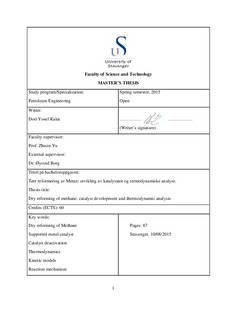| dc.description.abstract | With the concern of global warming resulted of greenhouse gases (GHG), continuous efforts have been devoted to address this issue by advanced chemical reaction technologies to convert the main GHG gas CO2 into useful products. Among the proposed solutions, dry reforming of methane (DRM) for synthesis gas (syngas) production emerges as a promising technology compared to the industrially applied technologies for syngas production.
DRM refers to the chemical reaction of methane and carbon dioxide to form hydrogen and carbon monoxide which are designated as synthetic gas. Due to the relatively low hydrogen to carbon monoxide ratio, this process is attractive for the Fischer-Tropsch (F-T) process of the Gas-to-Liquid (GTL) Technologies.
The DRM utilizes CO2 as an oxidant to react methane over heterogeneous catalyst and has important environmental implications because of the consumption of both CO2 and CH4, both significantly contributing to the greenhouse effect. Converting these gases into a valuable syngas will reduce the atmospheric emissions of CO2 and CH4. This thesis presents a comprehensive review of the catalyst design and preparation, catalytic activity and thermodynamics-kinetics analysis, and focuses on the catalyst deactivation which is the main concern of this process.
Heterogeneous catalyst for DRM generally consists of active species dispersed on mesoporous supports coupled with a promoter. Literature reports that group VIII metals onto oxides supports are effective for this catalytic process. Although noble metals demonstrate highest catalytic stability, the bimetallic Ni-based catalysts appears to be promising for future processes in industrial scale. Furthermore, mesoporous supports play an important role in both catalytic activity enhancement and coke deposition prevention. It is accepted that the Al2O3 and TiO2 supports are more promising, contribute to the enhanced catalytic activity and to the coke deposition prevention. In addition, promoters are non-active additives that improve the metallic dispersion over the support. Among the various reported promoters, Ce and ZrO2 show remarkable performance of minimizing carbon deposition and preventing active metal sintering. In this work, special attention is also paid to the investigation of catalysts design and synthesis. despite the fact that the catalyst preparation methodology is already well defined, the realization to obtain the exact structure, morphology and function of the produced catalyst is still hard to achieve and drives the further investigation on more controllable preparation and characterization methods.
Finally, studies on thermodynamic and kinetics of DRM is also elaborated. The thermodynamic equilibrium analysis is based on Gibbs energy minimization method and are interconnected to the kinetic reaction mechanisms. Thermodynamic variable optimization is not fully identified yet and play an important role for gaining high DRM efficiency. In general, the DRM is favored with low pressures of 1 bar, temperature range of 770-1170 °K and reactant (CO2+CH4) ratio close to unity.
DRM is a relatively simple reaction however its mechanism is difficult to predict and catalyst deactivation is still a great concern. Further systematic studies need to be done in order to achieve significant process improvement for the utilization of the DRM in large industrial scales. | nb_NO |
